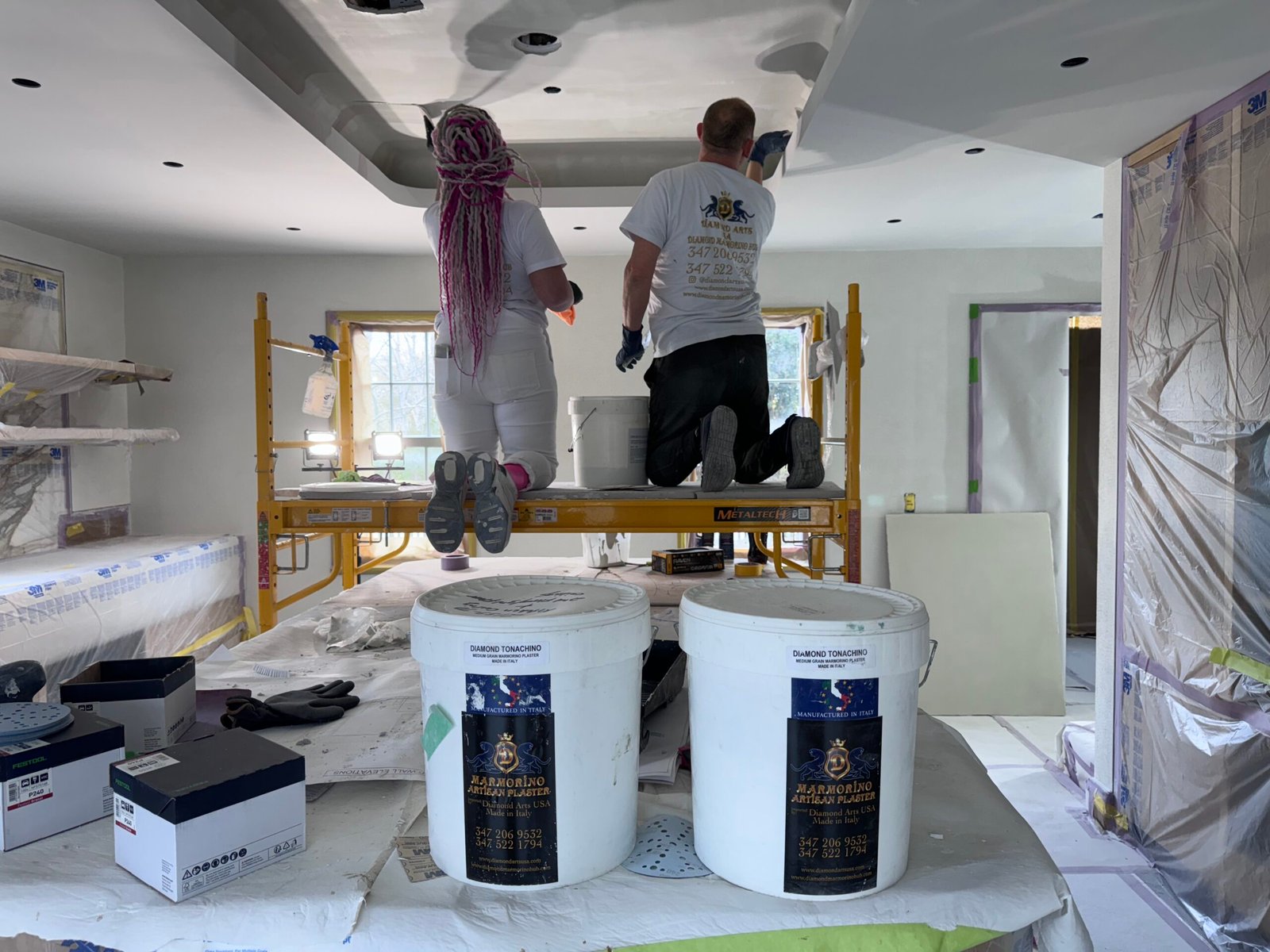Venetian plaster, renowned for its lustrous finish and historical significance, has been a cornerstone in the restoration of historic buildings, especially in a city as rich in architectural heritage as New York City (NYC). This article delves into the intricacies of Venetian plaster services tailored for historic edifices in NYC, emphasizing the importance of preserving architectural authenticity while integrating modern techniques.
Understanding Venetian Plaster
Venetian plaster, or “stucco Veneziano,” is a decorative finish comprising slaked lime, marble dust, and natural pigments. When meticulously applied, it yields a smooth, polished surface reminiscent of natural marble. This technique traces its origins to ancient Rome and was later perfected during the Renaissance in Venice, making it a preferred choice for opulent interiors.
Characteristics and Benefits
Aesthetic Versatility: Venetian plaster can emulate various textures, from polished marble to aged stone, offering a spectrum of design possibilities.
Durability: Its robust composition ensures resistance to cracking and fading, making it suitable for both interior and exterior applications.
Eco-Friendly: Crafted from natural materials, it is non-toxic and contributes to healthier indoor air quality.
Breathability: The plaster’s permeability allows walls to “breathe,” reducing moisture buildup and mitigating mold risks.
The Significance of Venetian Plaster in Historic Preservation
Historic buildings embody cultural narratives and architectural innovations of bygone eras. Maintaining their integrity necessitates materials and techniques that align with their original construction. Venetian plaster stands out in this regard due to its historical authenticity and adaptability.
Compatibility with Traditional Materials
Many historic structures feature lime-based mortars and plasters. Utilizing Venetian plaster ensures compatibility, preventing potential issues arising from material incompatibility, such as delamination or moisture entrapment.
Aesthetic Fidelity
The ability of Venetian plaster to replicate historical finishes allows restorers to maintain the building’s original aesthetic, ensuring that any intervention is seamless and respectful of the structure’s heritage.
Notable Historic Buildings in NYC Featuring Venetian Plaster
Several esteemed buildings in NYC have incorporated Venetian plaster in their design and restoration:
120 Broadway Lobby Ceiling
The Equitable Building at 120 Broadway underwent a significant restoration where experts reinstated the lobby’s ornamental and Venetian plaster to its former grandeur. This endeavor included recreating existing rosettes and restoring a large area of Venetian plaster.
Payne Whitney House
Located at 972 Fifth Avenue, the Payne Whitney House is a historic mansion showcasing Venetian plaster interiors. The building’s design reflects the opulence of the early 20th century, with intricate plasterwork contributing to its grandeur.
The Restoration Process: Merging Tradition with Modernity
Restoring Venetian plaster in historic buildings is a meticulous process that balances traditional craftsmanship with contemporary methodologies.
Assessment and Documentation
A thorough evaluation of the existing plaster’s condition is paramount. This involves identifying areas of deterioration, previous repairs, and underlying structural issues. Comprehensive documentation, including photographs and condition reports, guides the restoration strategy.
Material Analysis
Understanding the original plaster’s composition ensures that repair materials match in properties and appearance. This analysis may involve petrographic examinations and chemical testing.
Mock-Ups and Samples
Creating mock-ups allows conservators to test materials and techniques, ensuring compatibility and desired aesthetic outcomes before full-scale application.
Application Techniques
Skilled artisans apply the plaster in thin, multiple layers, each burnished to achieve the characteristic sheen. Attention to detail during application ensures the finish aligns with the building’s historical context.
Challenges in Restoring Venetian Plaster
Restoring Venetian plaster in historic buildings presents unique challenges:
Material Degradation
Over time, exposure to environmental factors can lead to plaster deterioration. Addressing this requires careful removal of damaged sections and integration of new plaster that harmonizes with the existing material.
Structural Issues
Underlying structural problems, such as settling foundations or water infiltration, must be resolved to prevent recurrent plaster damage.
Skilled Craftsmanship
The artisanal nature of Venetian plaster necessitates craftsmen with specialized skills. Ensuring that artisans are well-versed in traditional techniques is crucial for an authentic restoration.
Selecting a Qualified Venetian Plaster Specialist in NYC
Choosing the right professional is vital for a successful restoration. Consider the following factors:
Experience and Portfolio
Review the specialist’s previous projects, particularly those involving historic buildings, to assess their expertise and craftsmanship quality.
Certifications and Affiliations
Membership in professional organizations indicates a commitment to preservation standards and continuous learning.
Client Testimonials
Feedback from past clients provides insights into the specialist’s reliability, professionalism, and quality of work.
Case Study: Exemplary Restoration Projects
Several restoration firms exemplify excellence in historical restoration using Venetian plaster. Their approach combines traditional techniques with modern solutions to rejuvenate historic structures, ensuring a seamless blend of old-world charm and contemporary durability.
FAQs About Venetian Plaster Services for Historic Buildings in New York
Q. What is Venetian plaster?
Ans: Venetian plaster is a decorative finish made from slaked lime, marble dust, and natural pigments, used to create smooth, polished surfaces.
Q. Why is Venetian plaster ideal for historic buildings?
Ans: It closely resembles traditional lime-based materials, ensuring compatibility with historic structures while maintaining aesthetic authenticity.
Q. Can Venetian plaster be used for exterior restoration?
Ans: Yes, it is highly durable and can be applied to both interior and exterior surfaces, providing excellent resistance to weathering.
Q. How long does Venetian plaster last?
Ans: With proper maintenance, Venetian plaster can last for decades, developing a rich patina over time.
Q. Is Venetian plaster environmentally friendly?
Ans: Yes, it is made from natural materials and has excellent breathability, reducing indoor air pollutants.
Q. Does Venetian plaster require special maintenance?
Ans: Routine dusting and occasional polishing help maintain its appearance. Avoid harsh chemicals to preserve its integrity.
Q. What factors affect the cost of Venetian plaster restoration?
Ans: Factors include the extent of restoration, surface preparation, the complexity of design, and the artisan’s expertise.
Q. Can Venetian plaster be repaired if damaged?
Ans: Yes, professional restorers can blend new plaster with existing surfaces to create a seamless repair.
Q. How does Venetian plaster compare to modern synthetic finishes?
Ans: Venetian plaster is more sustainable, authentic, and breathable than synthetic alternatives, making it ideal for historic preservation.
Q. How can I find the best Venetian plaster specialists in NYC?
Ans: Research portfolios, check reviews, and consult historic preservation experts to find skilled professionals experienced in restoring historic buildings.
Final Thoughts On Venetian Plaster Services for Historic Buildings in New York
Venetian plaster plays an instrumental role in preserving the architectural heritage of NYC’s historic buildings. Its timeless appeal, durability, and compatibility with traditional materials make it an invaluable asset in restoration projects. By entrusting such endeavors to skilled artisans and reputable firms, these architectural treasures can be cherished for generations to come.

